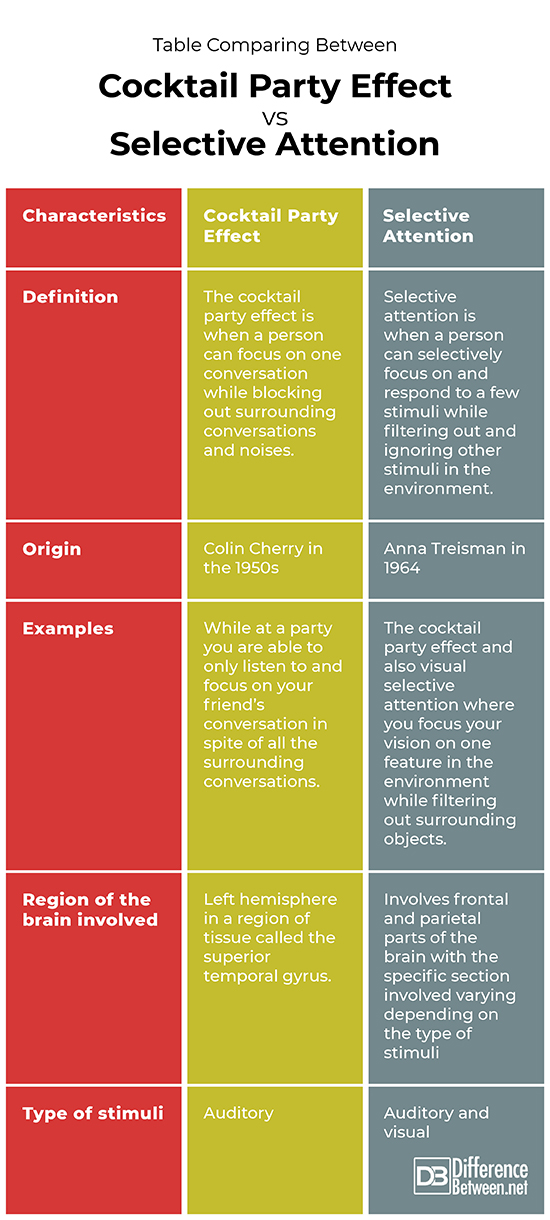Difference Between Cocktail Party Effect and Selective Attention
The cocktail party effect is the idea that you can selectively focus on one conversation and ignore surrounding conversations. Selective attention is the ability to select what to focus on in terms of what you see or hear in the midst of background noise and sights.

What is Cocktail Party Effect?
Definition:
The cocktail party effect is when a person is able to focus only on their conversation with one person while in the midst of a social setting where there are many conversations going on. This is a type of auditory selective attention.
Examples:
The classic example of the cocktail party effect is that your brain is able to filter out surrounding conversations so you focus on your friend’s conversation. You are able to ignore other people talking in the background while able to clearly hear and comprehend your friend.
History of the cocktail party effect:
The phenomenon was first described in the 1950s by Colin Cherry. He completed various experiments to test how people hear and how they can focus on different conversations.

What is Selective Attention?
Definition:
Selective attention is defined as the ability of an individual to focus their attention on only one or a few sensory stimuli while ignoring other stimuli in the environment. It can take the form of auditory or visual stimuli.
Examples:
The cocktail party effect is one example of selective attention, specifically relating to auditory stimuli. Another example is that of visual selective attention. In this case, we focus our attention and sight on specific objects in the environment while ignoring others.
History of selective attention:
The theory of selective attention was suggested in 1964 by Anna Treisman. Her work was based on earlier findings by Broadbent in 1958 that suggested that people decide what stimuli and information to focus on. More recently, scientists have theorized that humans have only limited attention and so cannot focus on multiple stimuli at once, leading to selective attention.
Difference between Cocktail party effect and Selective attention
Definition
The cocktail party effect is when a person can focus on one conversation while blocking out surrounding conversations and noises. Selective attention is when a person can selectively focus on and respond to a few stimuli while filtering out and ignoring other stimuli in the environment.
Origin
Colin Cherry came up with the idea of the cocktail party effect in the 1950s. Anna Treisman in 1964 derived the idea of selective attention.
Examples
An example of the cocktail effect is when you are at a party and you are clearly capable of listening to your friend’s conversation in spite of all the surrounding conversations. An example of selective attention is the cocktail party effect but also visual selective attention where you focus your vision on one feature in the environment while filtering out surrounding objects and stimuli.
Region of the brain involved
In the case of the cocktail effect, the part of the brain involved is the superior temporal gyrus of the left hemisphere. In the case of selective attention, parts of the parietal and frontal lobes of the brain are involved.
Stimuli
With the cocktail party effect only auditory stimuli are involved. In the case of selective attention, auditory and visual stimuli are involved.
Table comparing between Cocktail party effect and Selective attention

Summary of difference between Cocktail party effect and Selective attention
- The cocktail party effect is one type of selective attention in which hearing is involved.
- Selective attention can involve hearing or vision.
- Both the cocktail party effect and selective attention involve activity in certain areas of the brain.
FAQ
What is an example of the cocktail party effect?
A person is able to listen to a friend’s conversation while filtering out and largely ignoring surrounding background noises.
What’s an example of selective attention?
The cocktail party effect is an example of selective attention. Another example is the ability to focus your sight on only one stimulus while ignoring all others in the surrounding area and environment.
What is the cocktail party effect also known as?
The cocktail party effect is also called selective hearing or selective auditory attention.
Is the cocktail party effect early or late selection?
The cocktail party effect is believed to be an example of late selection rather than early selection.
How does the cocktail party effect function as an example of selective attention?
In the case of the cocktail party effect, a person is able to selectively focus and hear one person speaking against a background of other conversations and noises.
What is selective attention in psychology?
It is the ability to selectively concentrate and focus attention on only one or few stimuli while filtering out and largely ignoring surrounding sounds and sights.
- Difference Between Rumination and Regurgitation - June 13, 2024
- Difference Between Pyelectasis and Hydronephrosis - June 4, 2024
- Difference Between Cellulitis and Erysipelas - June 1, 2024
Search DifferenceBetween.net :
Leave a Response
References :
[0]Moore, Tirin, and Marc Zirnsak. "Neural mechanisms of selective visual attention." Annual review of psychology 68.1 (2017): 47-72.
[1]Pollack, Irwin, and James M. Pickett. "Cocktail party effect." The Journal of the Acoustical Society of America 29.11 (1957): 1262-1262.
[2]Yantis, Steven. "The neural basis of selective attention: Cortical sources and targets of attentional modulation." Current directions in psychological science 17.2 (2008): 86-90.
